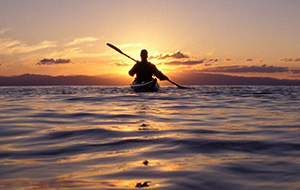One issue with living in a beach community–especially a resort area like the Outer Banks–is the sand and the surf are so wonderful that visitors may miss a whole range of experiences on the other side of the sandbar. The sounds that form the western border of the Outer Banks are beautiful ecological wonders just waiting to be explored. Shallow and generally fairly calm, they are ideal bodies of water to be explored in a kayak.

For people who have not been kayaking, the basics are fairly easy to learn and the kayaks used on the flat waters of the sounds are stable–so stable that you actually have to work to tip one over. There are so many options for exploring the Outer Banks by kayak, that it’s not possible to list all the choices, so I’ll just reference a couple of personal favorites.
Pea Island National Wildlife Refuge is the strip of sand just south of the Bonner Bridge (Oregon Inlet). About four or five miles south of the bridge there is a parking area and launch site called New Inlet–because it was an inlet at one time. There are a number of operators that take tours out from there, or for more experienced paddlers, it’s a great place to explore on your own. The line of wood pilings easily seen in the Pamlico Sound supported a bridge that existed until the 1930s.
At the other end of the Outer Banks, in Corolla, the Currituck Sound is a fascinating body of water to explore. Filled with small islands, marshes and on the far northern end, canals, it is a perfect environment for a family to spend an hour and a half or two hours exploring.
Coastal Explorations does have a trip to Monkey Island–once one of the most storied of the Currituck hunt clubs but now a decaying ruin that has one of the most productive rookeries on the East Coast. This is a tour that is strictly for more experienced paddlers, but should be worth the effort.
Not all the tours are on the Outer Banks. Some of the most interesting places to explore are just across the sounds at Alligator River National Wildlife Refuge. The waters are the northern most reach of the American alligator, and yes, you may see a few of them. The area is a unique intersection of temperate and subtropical systems that has created a very different ecosystem.
Historical Note: At the turn of the 20th century, Buffalo City with a population of 2500 was a thriving lumber town surrounded by cedar and juniper in the heart of Alligator River. By the end of the 1920s it was abandoned and except for the railroad beds that transported the logs, the swamp has completely reclaimed its own.
There are so many operators who offer very good quality kayak tours that we can’t list them all. As a starting point, here are four of the larger operators: Coastal Explorations, Coastal Kayak, Kitty Hawk Kites and Back Country Safari Tours.
